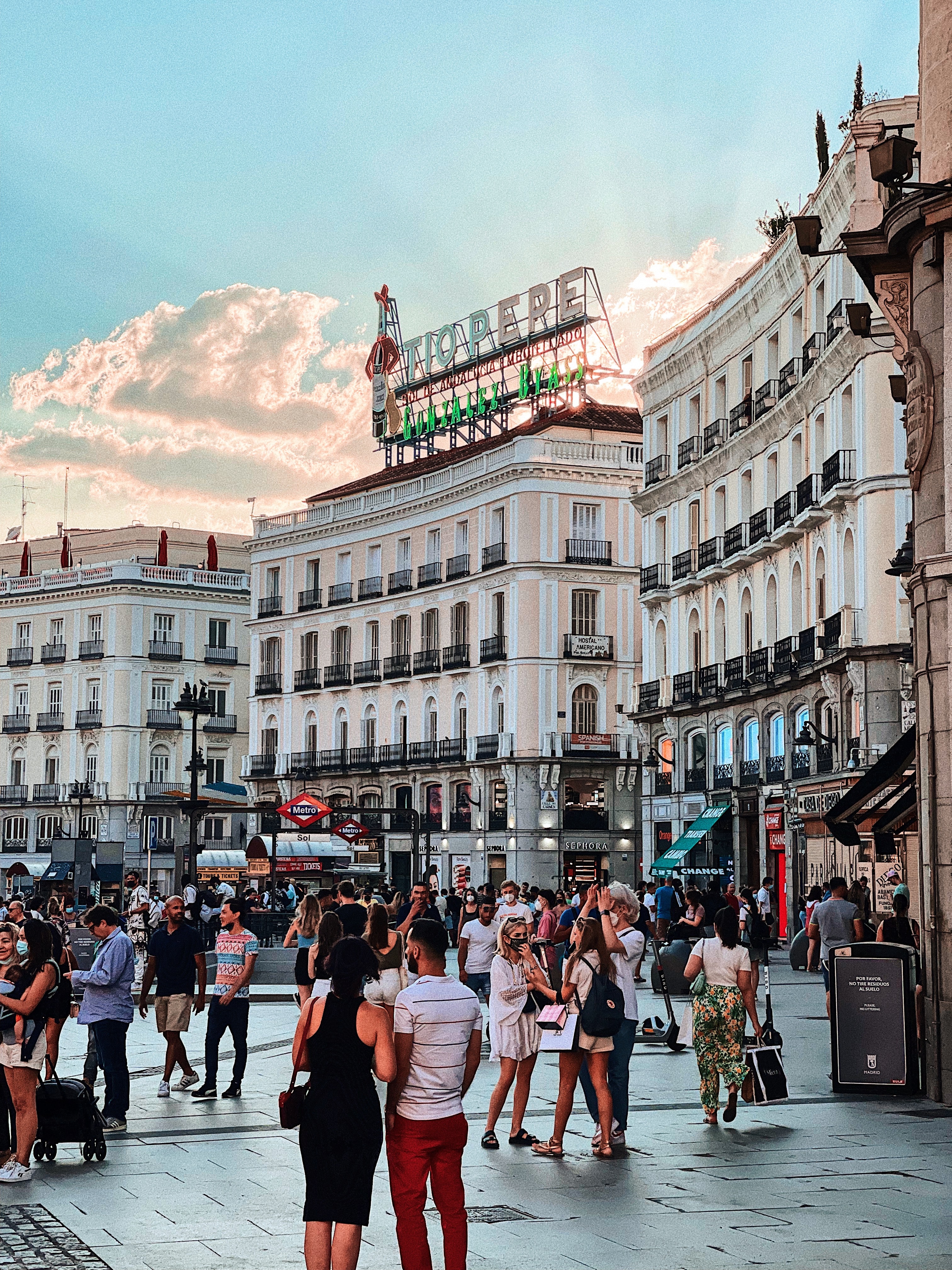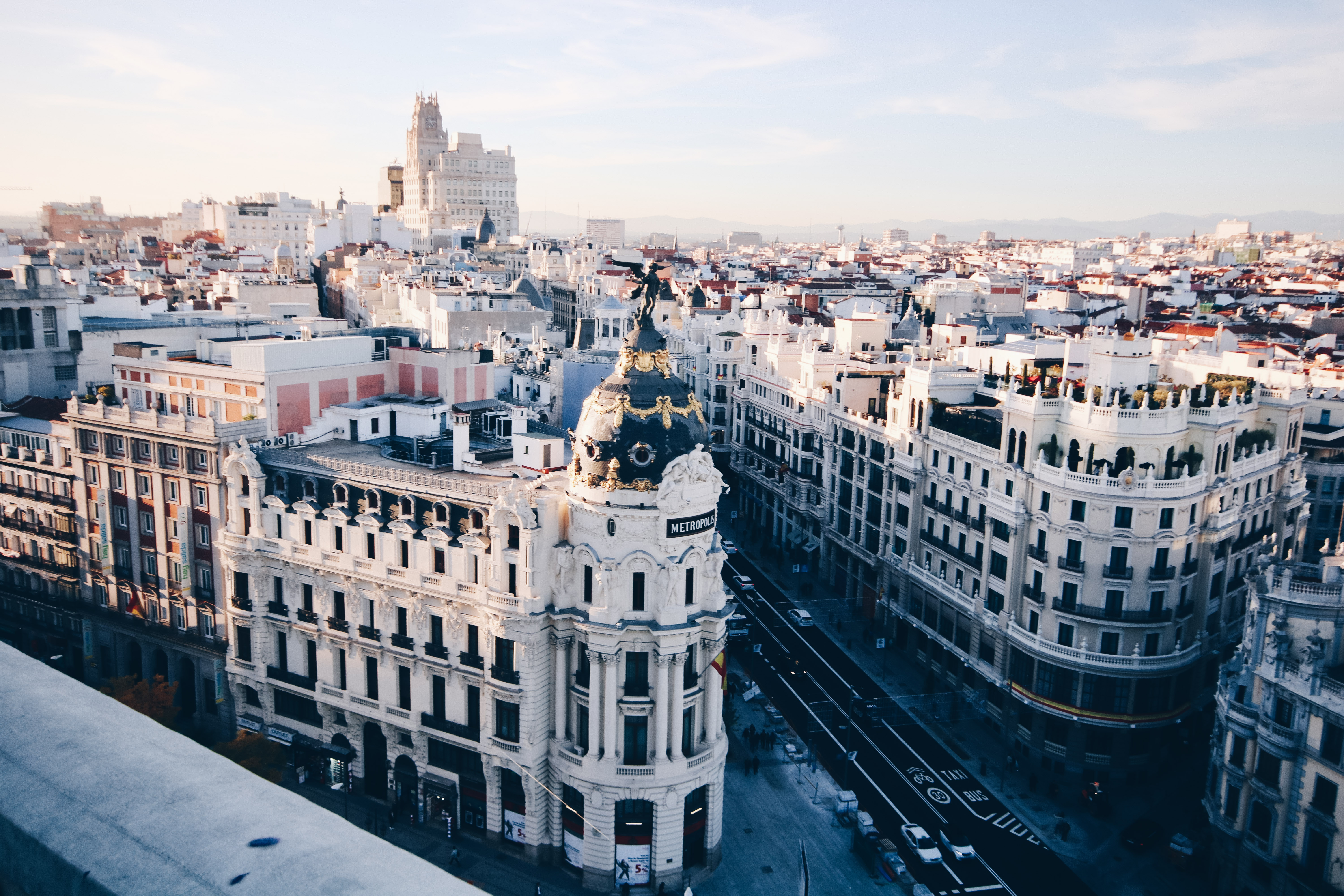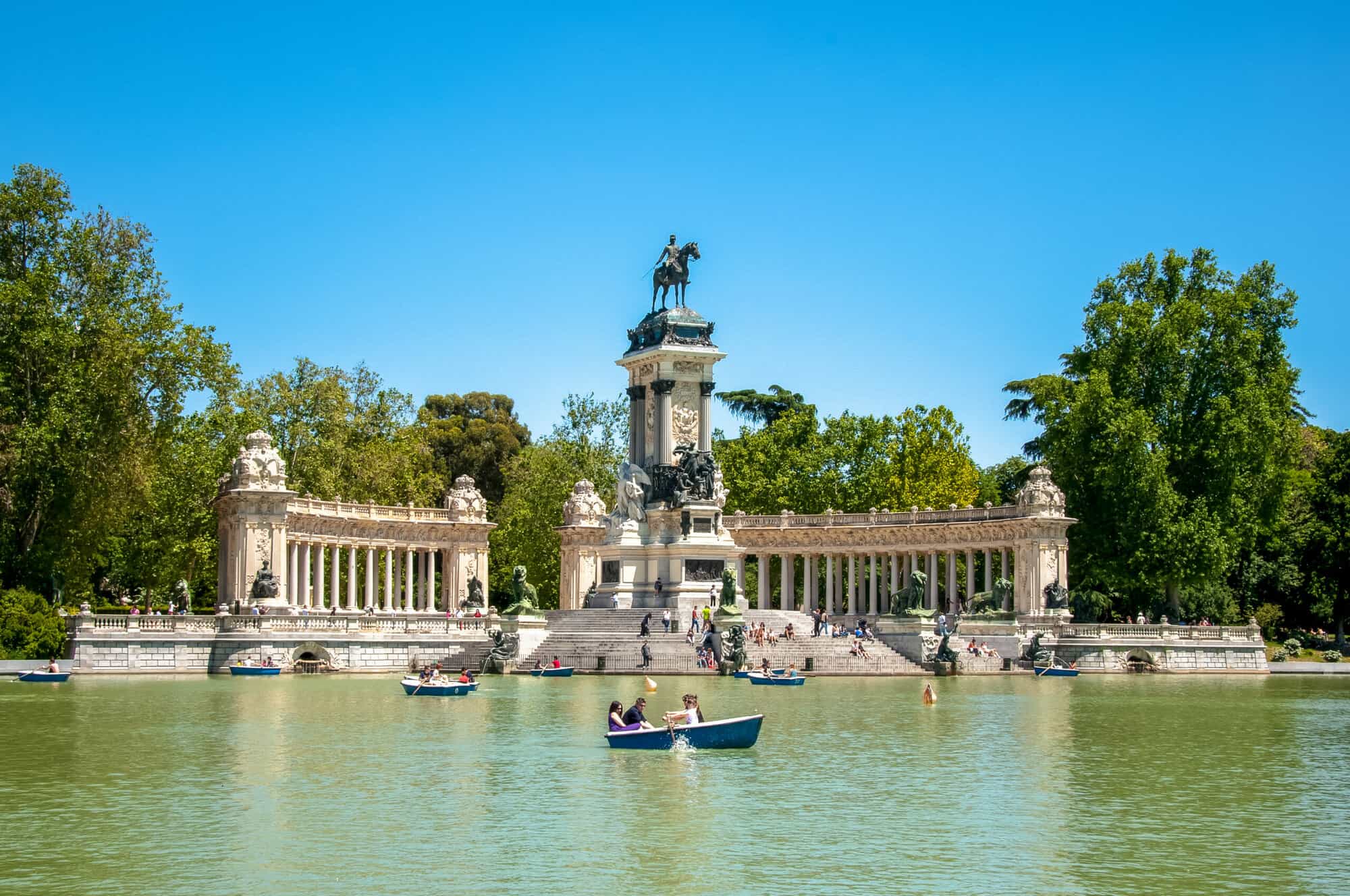Museum trips are a beloved and integral part of any city trip, and Madrid has some of Europe’s best. Indeed, especially when it comes to art museums, Spain’s capital punches above its weight, and the Prado and Reina Sofía easily hold their own against the continent’s other heavy-hitters. Madrid’s many museums attract millions of visitors each year and are essential to the city’s cultural and tourism industries, with many visitors coming specifically to explore the city’s art and history.

View of Plaza Mayor, Madrid. Source: Unsplash
Some of Madrid’s most famous museums include the Museo Nacional del Prado, which boasts an expansive collection of European art from across the ages, and the Museo Nacional Centro de Arte Reina Sofía, featuring works from modern and contemporary Spanish artists. The museums of Madrid play a crucial role in preserving and celebrating the city’s past and present. In Madrid, you’ll find museums that appeal to everyone, from history buffs to architecture nerds to art lovers.
How to get to Madrid’s city center from Madrid Barajas Airport
Getting from the Madrid-Barajas Airport to Madrid’s city center couldn’t be easier. Madrid’s expansive, affordable and well-connected metro system shuttles you between Madrid airport and the city center in a flash: just board metro line 8 at the airport’s attached metro station and your journey to the city center will take about 15 minutes. However, if you’re arriving at the airport between 1:30 a.m. and 6 a.m., the metro will be unavailable. In this case, your best option is to get bus 203 at Plaza Cibeles or O’Donnell Station, which runs 24/7.
Museo Nacional del Prado
The Prado Museum has to be the most famous museum in Madrid – and in all of Spain. Its fabulous and expansive collection of art from Spain and around the world draws millions of visitors every year and puts it on par with the likes of the Louvre, New York’s Metropolitan Museum, and the British Museum.
The Prado, as it’s commonly known, was founded in 1819 as the Royal Museum of Painting and Sculpture, and was originally intended as a way to publicly display works from the collection of art that had been accumulated by the Spanish royal family. Fast forward 200-odd years, and the collection contains more than 35,000 drawings, prints, sculptures and paintings dating from the 12th all the way to the 21st century and including some of the most notable works in history.
Among the Prado Museum’s collection are works by some of the most famous artists in history, such as Diego Velázquez, Francisco de Goya, El Greco and Hieronymus Bosch. It should go without saying that Prado’s collection of Spanish art is perhaps one of the most extensive in the world, boasting large collections of Spanish masters like the aforementioned Goya and Velázquez. There are also sizable collections of works by Italian, Flemish and Dutch artists, among others.
One of the most notable works in the Prado’s collection is Las Meninas, by Velázquez. This 1656 masterpiece depicts the Spanish royal family and their court in a dramatic fashion and is considered one of the most important works of Baroque art due to its complex composition and use of light and shadow. Another celebrated painting is The Third of May 1808 by Goya, depicting the execution of Spanish citizens by French soldiers during the Peninsular War – an allegorical depiction of the dawn of the modern Spanish national identity. Bosch’s The Garden of Earthly Delights, the triptych depicting the creation of man and the dual pleasure and torment of earthly life, is also on display.
Traveling to the Prado Museum
The metro makes it simple to get to the Prado Museum. Visitors should exit line 1 at the Atocha station or line 2 at the Banco de España station; the Prado is a short walk away from both. There are also buses and taxis available.

Couple looking over Central Madrid. Source: Unsplash
Museo Nacional Centro de Arte Reina Sofía
If the Prado is the king of Madrid’s art museums, then the Reina Sofía stays true to her name as the queen of them. Though it was only established in 1990, the Reina Sofía Museum is one of the most signification and influential contemporary art museums in the world. Named after the Queen Mother Sofía, wife of King Emeritus Juan Carlos I, the museum’s collection contains works by many of the most influential Spanish artists of the 20th century, including artistic heavy hitters like Pablo Picasso, Salvador Dalí and Joan Miró. It also includes some important works from non-Spanish artists like Louise Bourgeois and Francis Bacon.
The collection is housed in a former hospital constructed back in the 1800s. The building’s architecture preserves much of its neoclassical style, but these are complemented and contrasted by contemporary additions like a large glass elevator and panoramic tower.
No discussion about the Reina Sofía Museum would be complete without mentioning Picasso’s iconic Guernica, a massive mural-sized work that depicts the bombing of Basque town of the same name by fascist German and Italian planes. The attack killed more than 800 people and quickly became an international symbol of the horrors of modern war. At the Reina Sofía, the expansive painting dominates an entire room: it is arguably the centerpiece of the entire collection.
Traveling to the Reina Sofía museum
It’s easy to get to the Reina Sofía museum by public transport. Atocha (line 1) and Lavapiés (line 3) are the closest metro stations and both are walking distance from the museum.
Thyssen-Bornemisza Museum
Madrid is well-stocked with famous art museums, and this article has already discussed two of them. However, any list of the best art museums in Madrid would be remiss if it didn’t mention the Thyssen-Bornemisza Museum. Established in 1992, the museum is housed in the beautiful Palacio de Villahermosa, an 18th-century palace that was expanded and renovated to accommodate the extensive collection.
The collection includes works by some of history’s most important artists, with a special focus on Impressionist and Post-Impressionist works from the 19th and 20th centuries. It also houses important paintings by artists like Edgar Degas, Claude Monet and Vincent van Gogh, as well as more modern additions by Jackson Pollock and Edward Hopper.
Perhaps the most well-known work in the Thyssen-Bornemisza collection is Vermeer’s iconic Woman with a Pearl Necklace, renowned for its masterful use of light and shadow. Other important works include Dalí’s Dream Caused by the Flight of a Bee Around a Pomegranate a Second Before Awakening and Edward Hopper’s Nighthawks.
Traveling to the Thyssen-Bornemisza Museum
The Thyssen-Bornemisza Museum is accessible by traveling to Sol station (metro lines 1, 2, and 3).
Museo Sorilla
The Museo Sorilla is the first museum on this list that is dedicated to a single topic: in this case, the life and works of renowned artist Joaquín Sorilla. The museum is housed in the artist’s former home and studio in the Chamberí neighborhood of Madrid, and the space has been preserved as it was when the artist died.
Joaquín Sorilla was a well-respected figure in Spain’s art world at the turn of the 20th century, known for his depictions of rural and coastal Spanish life and portraits of the people who lived and worked in those places. The collection contains many of the oil paintings that made him famous, but also watercolors and sketches.
One of the most notable works is the famous painting La Siesta, which depicts several Spanish women in white dresses enjoying a nap on a grassy field. It is said to be a masterpiece of light and color that catches the essence of the Spanish countryside.
Traveling to Museo Sorilla
Museo Sorilla can be reached by traveling to Iglesia station (line 1), Rubén Darío station (line 5) or Gregorio Marañón station (lines 7 and 10).
The Museo Arqueológico Nacional
Taking a step away from art, let’s take a dip into the archeological history of Spain. This collection, one of the largest in the country, showcases artifacts and artistic works from every era of Spain’s history, from prehistory all the way to the present day. The museum is located in a beautiful neoclassical edifice purpose-built for the collection in the late 19th century.
The curators have assembled a horde of archeological artifacts that date back from Spain’s prehistoric past, through the Roman era up to the modern day. The collection is helpfully organized chronologically, so viewers can travel through the ages as they browse the museums exhibitions, from sections dedicated to the Bronze Age, ancient Iberian civilizations, the Greek and Roman periods and the Islamic era, through to the age of the Catholic monarchs and modern Spain. There are also sections dedicated to the Spanish conquest of the Americas.
One of the most notable and mysterious works in the Museo Arqueológico Nacional’s collection is the so-called “Lady of Elche”, a sculpture which dates back to the 4th century BCE and the enigmatic Iberian civilization. The female figure, clad in elaborate headwear, is thought to represent a goddess or priestess from that civilization. The intricate carving and mysterious provenance have made it one of Spain’s most treasured artifacts.
Traveling to the Museo Arqueológico Nacional
Museo Sorilla can be reached by traveling to Retiro or Serrano stations, served by metro lines 2 and 4.
Museo del Romanticismo
The Museo del Romanticismo is a museum with an unusual approach: showcasing everything about a certain era. In this case, the museum is an opportunity to travel back in time to Spain’s early 19th century – the Romantic period. Here, in Madrid’s beautiful Chueca neighborhood, visitors can get a glimpse of the art, culture and daily life that made the epoch such a special part of Spanish history. Located in a chronologically appropriate 18th century building, the effect is quite comprehensive.
The museum is housed in the gorgeous Palacio del Marqués de Matallana, built in the neoclassical style in the late 18th century, placing its construction right in the middle of Spain’s Romantic period. The beautiful colonial-style edifice would not look out of place in the old town of Lima or Bogotá, and the interior is impeccably decorated with period furnishings.
The collection of the Museo del Romanticismo is organized around showcasing art and artifacts from Spain’s Romantic period, which spanned from the late 18th to mid-19th century. It features paintings, sculptures, furniture and other artistic works, but also everyday objects and personal items that let viewers travel back in time and get a feel for what daily life was like in those times. One of the most notable works is Goya’s famous El Gigante, a portrait of a man who was said to have been nearly 8 feet (2.4 meters) tall.
The museum also features beautiful gardens that showcase a mix of native and exotic plants, all planted in the Romantic style, featuring winding paths, fountains and seating areas so that visitors can take a few moments out of their day for reflection.
Traveling to the Museo del Romanticismo
The closest metro stations to the Museo del Romanticismo are Tribunal, served by lines 1 and 10, and Noviciado, served by metro line 2.

View of central Madrid from above. Source: Unsplash
Madrid National Museum of Natural Sciences
Madrid’s National Museum of Natural Sciences is unique among natural history museums in that it was founded way back in 1771, making it one of the first of its kind. It remains one of the most important, too, with a collection of more than six million specimens from around the world, including fossils, minerals, plants and animals.
The collection is organized thematically into different sections dedicated to various areas of the natural sciences. One of the most popular exhibits, especially for the smaller guests, is the dinosaur exhibit, which features a grand collection of fossils and replica fossils. There are also detailed, life-sized models of some of the most beloved dinosaurs out there, such as Triceratops and T-rex. The kids love it!
Once you’ve gotten the giant lizards out of the way, it’s time to get local with perhaps the world’s largest collection of wildlife specimens collected in every corner of Spain, from the Basque country to the Canary Islands. The museum’s mineral collection is also nothing to sneeze at, boasting over 100,000 crystals, gemstones and various other rocks collected all around the world.
Traveling to the National Museum of Natural Sciences
The closest metro station to the National Museum of Natural Sciences is the Gregorio Marañón, served by metro lines 7 and 10. It’s just a 300-foot (100 meter) walk from there to the museum.
Museo Nacional de Antropología
The Museo Nacional de Antropología traces the story of human cultures as they developed around the world, following our species’ story from prehistory into the present day. A visit to this museum allows visitors a glimpse into the fascinating diversity of cultures, histories and traditions around the world. Founded in 1875, it’s one of the oldest and most renowned anthropological museums in Europe, with a collection that includes over 90,000 human artifacts from every continent except Antarctica.
The collection is organized into different sections according to geographic region. The museum’s African collection features objects from all over the continent, from a collection of masks and sculptures from West Africa to East African textiles and stringed instruments along with contemporary works of art by up-and-coming African artists. The American section likewise includes many artifacts taken by the Spanish after their conquest, such as a collection of pre-Columbian gold items from the Quimbaya civilization in Colombia.
Traveling to the Museo Nacional de Antropología
The Museo Nacional de Antropología can be found in Madrid’s Moncloa-Aravaca district. The closest metro stop is Ciudad Universitaria on metro line 6.
Museo de Historia de Madrid
You’ve spent a lot of time learning in Madrid; how about learning about Madrid for once? Located in the historic La Latina neighborhood, the Museo de Historia de Madrid traces the history of the city from its 8th-century origins as a military fort to its days as an imperial capital to its modern cosmopolitan self. It’s housed in a former hospital, the 18th-century San Fernando Hospital, a gorgeous historic edifice that has been lovingly restored.
The collection is focused on the history of Madrid from its founding and prehistory all the way up to the present day and includes a wide range of historic and prehistoric artifacts to illustrate that history. The museum brings history to life with displays of everything from prehistoric stone axes to Roman-era statues to oil paintings from the Medieval and Renaissance eras. For more recent time periods, the collection expands to include newspaper clippings, photographs, documents and personal items owned by notable figures from Madrid’s history.
One of the most well-known works in the museum’s collection is Francisco de Goya’s The Third of May 1808 a painting depicting a scene from the Spanish War of Independence during the Napoleonic Wars. The execution of Spanish rebels in Madrid is commonly understood as having provided the first seeds for modern Spanish national identity, and the painting is a powerful reminder of the hardship that Madrid’s people have faced.
There are a number of interactive exhibits that are particularly interesting for the younger museum goers. One notable exhibition is a virtual reality tour of Madrid as it was during the Middle Ages – viewers can just strap on the glasses to be immediately immersed in the sights and sounds of 14th-century Madrid. There’s also a detailed scale model of the city as it was during the 19th century.
Traveling to the Museo de Historia de Madrid
The easiest way to travel to the Museo de Historia de Madrid is to take metro line 5 to the La Latina stop. From there, it’s only a 650-foot (200 meter) walk to the museum.
